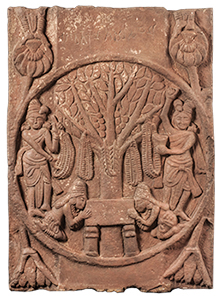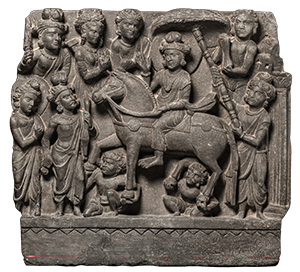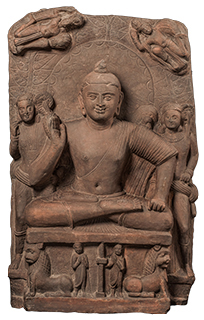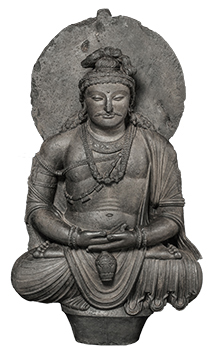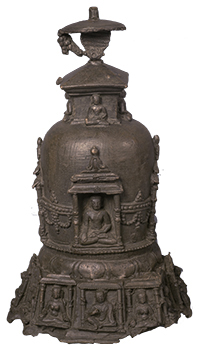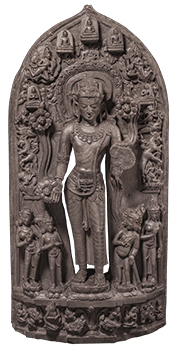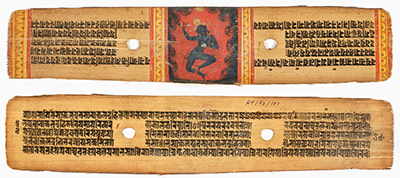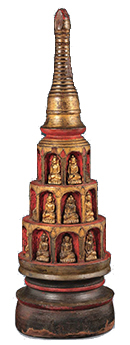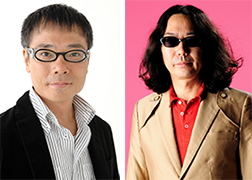1089ブログ「コルカタ・インド博物館所蔵 インドの仏 仏教美術の源流」 展覧会の見どころなどを紹介しています。
東京国立博物館 資料館 特別展「インドの仏」関連図書コーナー設置
展覧会のみどころ
第1章 仏像誕生以前
第2章 釈迦の生涯
第3章 仏の姿
第4章 さまざまな菩薩と神
第5章 ストゥーパと仏
第6章 密教の世界
第7章 経典の世界
附編 仏教信仰の広がり
コルカタ・インド博物館について
第1章 仏像誕生以前
古代初期の仏教寺院はストゥーパ(仏塔)を中心につくられました。ストゥーパを取り囲む欄楯(らんじゅん)と呼ばれる囲いを、釈迦の生涯、その前世の物語であるジャータカ(本生)、神像、蓮華文様などで装飾しました。当時、仏陀は人間の姿では表されず、法輪や聖樹、足跡などによって存在を暗示するのが習わしでした。中インドのバールフットは古代初期を代表する仏教遺跡です。高さ3mに及ぶ巨大な欄楯に施された浮彫彫刻の造形は、古拙ながら力強さがみなぎっており、見る者を圧倒します。
菩提樹 (カナカムニ仏) の礼拝
バールフット出土
シュンガ朝(紀元前2世紀頃)
釈迦よりも前に世にあって悟りを開いたとされる過去七仏の一人、カナカムニ仏を礼拝する場面。画面の中央、人々の合掌、散華する先には、空の台座と花綱で飾られた樹木があるのみで、仏はこれらによって象徴的に表されています。古代初期にはこのように仏陀不表現のルールが守られていました。
展覧会のみどころトップへ
第2章 釈迦の生涯
インドで最初に仏像が作られたのは、ガンダーラと北インドのマトゥラーで、紀元後1世紀頃のことと考えられています。この時代に北インドから中央アジアを支配したのはクシャーン朝で、仏教美術も大いに隆盛しました。
特にガンダーラでは、釈迦の生涯をたどる仏伝説話の美術が発達しました。釈迦の偉大さを示すために、説話には超自然的な出来事も数多く含まれています。ここでは、時代を超えて愛好された仏伝美術の作品の数々を紹介します。
仏伝「出家踰城(しゅっけゆじょう)」
ロリアン・タンガイ出土
クシャーン朝(2世紀頃)
王子として育ったシッダールタ太子(のちの仏陀)が、出家をするためにカピラヴァストゥの城を出ていく場面です。馬の蹄の音で周りに気付かれないために、ヤクシャ神が蹄をもち、太子には傘が差しかけられ、太子の周りでは神々が太子の出家を讃嘆しています。
展覧会のみどころトップへ
第3章 仏の姿
仏像の誕生以後、礼拝像としてさまざまな仏が作り出されました。仏像の誕生から間もない頃の仏陀像の多くは、釈迦の姿を表わしたと思われますが、ガンダーラ美術独特の説法図にみられる仏は、阿弥陀仏など大乗仏教の仏ではないかとする説もあります。また、出家して悟りを開いた仏は、本来装飾を身につけませんが、宝冠や首飾などで飾られた仏も作られるようになります。
仏坐像 (ぶつざぞう)
アヒチャトラー出土
クシャーン朝(1世紀頃)
ガンダーラと並んで仏像が最初に作られたマトゥラーでは、みずみずしい肉体をもった青年のように仏が表されました。頭髪は頭頂部に渦巻型に髪を巻いた形で、薄い衣を右肩をあらわにして身につけるのが初期のマトゥラー仏の特徴です。仏の座には一対の獅子がいます。これは仏が釈迦族の獅子と呼ばれたことを造形化したものです。
展覧会のみどころトップへ
第4章 さまざまな菩薩と神
悟りを開いた仏に対して、修行を経て未来に仏になるものを菩薩と呼びます。大乗仏教の興隆とともに、人々を救済するものもこう呼ばれるようになり、その種類も増えていきます。インドの王族の姿を原型とする菩薩は、冠や首飾などの装飾をつけています。菩薩には各々に特徴があり、髪型や宝冠、そして持物の種類によって区別することができます。また、仏教はインド古来あるいは外来の神々を取り入れ、それらは守護神など様々な役割を担いました。
弥勒菩薩坐像 (みろくぼさつざぞう)
ロリアン・タンガイ出土
クシャーン朝(2世紀頃)
弥勒は現在、兜率天(とそつてん)という天の世界にいて、釈迦の入滅(にゅうめつ)から数えて56億7千万年後にこの世に生まれて釈迦と同じように悟りを開いて仏となり、人々を救うとされます。ガンダーラでは弥勒の信仰も盛んに行なわれました。弥勒菩薩は、髪を束ね、手に水瓶(すいびょう)を持つ姿で表わされます。豪華な装飾品を身につけるのは、釈迦が出家をする前のシッダールタ太子の姿が元になっています。
展覧会のみどころトップへ
第5章 ストゥーパと仏
古代初期のインドでは、仏教徒の信仰の対象は仏の舎利(しゃり)を納めたストゥーパ(仏塔)でした。仏像の誕生後も、ストゥーパの信仰はさまざまに形を変えながらも継続していきます。ストゥーパの中には、仏の舎利を意味するさまざまなものが納入されました。また、仏のみならず亡くなった僧のためにもストゥーパは造営されました。
奉献塔(ほうけんとう)
アシュラフブール出土
パーラ朝(8世紀頃)
展覧会のみどころトップへ
第6章 密教の世界
仏教の教えが次第に複雑になり、インドでは5~6世紀頃に密教が生まれたと考えられます。インドで次第に隆盛してきたヒンドゥー教の影響を受け、多面多臂(ためんたひ)の密教像が作り出されたり、仏、菩薩、護法尊、天のそれぞれに多様な尊格が生まれ、仏たちの世界を形作っています。東インドのベンガル地方では7世紀頃から密教が盛んになります。8世紀に東インドで興ったパーラ朝は、王たちが仏教を手厚く保護し、大寺院を各地に建立しました。
カサルパナ観音立像
チョウラパーラ出土
パーラ朝(11~12世紀頃)
中央の観音は、右手は与願印(よがんいん)を結び、左手で蓮華の茎を持っています。観音の右に、ターラーとスダナクマーラ、左にハヤグリーヴァ、ブリクティの合計四尊が従い、頭上には仏の右脇から大日、宝生(ほうしょう)、阿弥陀、阿閦(あしゅく)、不空成就(ふくうじょうじゅ)の五仏を配しています。このような組み合わせの像をカサルパナ観音あるいは空行世自在(くうぎょうせじざい)と呼びます。カサルパナとは「空中を遊行するもの」の意味で、密教において多様化した観音のひとつです。緻密な玄武岩を彫り出した姿は、研ぎ澄まされた美しさを備えています。
展覧会のみどころトップへ
第7章 経典の世界
仏教の教えは、もともと口伝でしたが、次第に文字で残されるようになります。紙のない時代のインドでは、樹皮やヤシの葉などに経文を記し、それを綴じて保管していました。紙が用いられるようになっても、その形式は存続しました。
八千頌般若波羅蜜多経 (はっせんじゅはんにゃはらみたきょう)
バレンドラ・ブーミ派
パーラ朝(11世紀頃)
ヤシの葉に経を記したいわゆる貝葉経(ばいようきょう)で、インドで古くから用いられました。八千頌般若波羅蜜多経は、大乗仏教の中で最も重要な経典のひとつで、その成立は紀元前後頃までさかのぼると考えられています。同経が長い間流布していたことは、東インドやネパールで数多くの写本が見つかっていることからもわかります。この作品では中央の区画に、青い体で3つの目を持ち、歯を剥いた忿怒(ふんぬ)の形相の女尊ナイラトナ(無我女)を描いています。右手にカルトリという曲刀、左手に髑髏の杯を持つのは、他の多くの忿怒像にもみられます。左脇には髑髏杖を抱えています。
展覧会のみどころトップへ
附編 仏教信仰の広がり
本章では、インドに加え、隣国のミャンマー(ビルマ)の仏教美術作品も紹介します。仏教はインドから中央アジア、東南アジア、東アジアの広範な地域へと広まりましたが、インドで仏教が衰えたのちも、周辺諸国ではさまざまな形で仏教信仰が続きました。ミャンマーでは5世紀頃には仏教が伝わっていたようですが、バガン朝(1044 ~1299)に上座部仏教が主流となり、東南アジアの上座部仏教流行の一翼を担いました。上座部仏教で伝わった本生説話のうち、最も有名なヴェッサンタラ本生を表わした作品を中心に紹介します。
仏塔
16~17世紀
ミャンマー
展覧会のみどころトップへ
コルカタ・インド博物館について
インド東部の大都市コルカタ(旧カルカッタ)に英国統治時代の1814年に創立したアジア最古の総合博物館で、収蔵品は人文科学、自然科学の多様な領域に及びます。古代インド美術のコレクションは世界的にも有名で、バールフット・ストゥーパの「欄楯(らんじゅん、垣)」を復元したギャラリー(写真右)は圧巻です。コロニアル風の重厚な建築も見どころです。
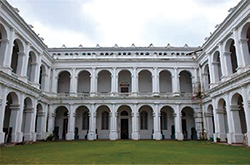
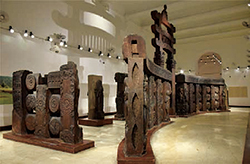
展覧会のみどころトップへ
Photographs (c)Indian Museum, Kolkata


